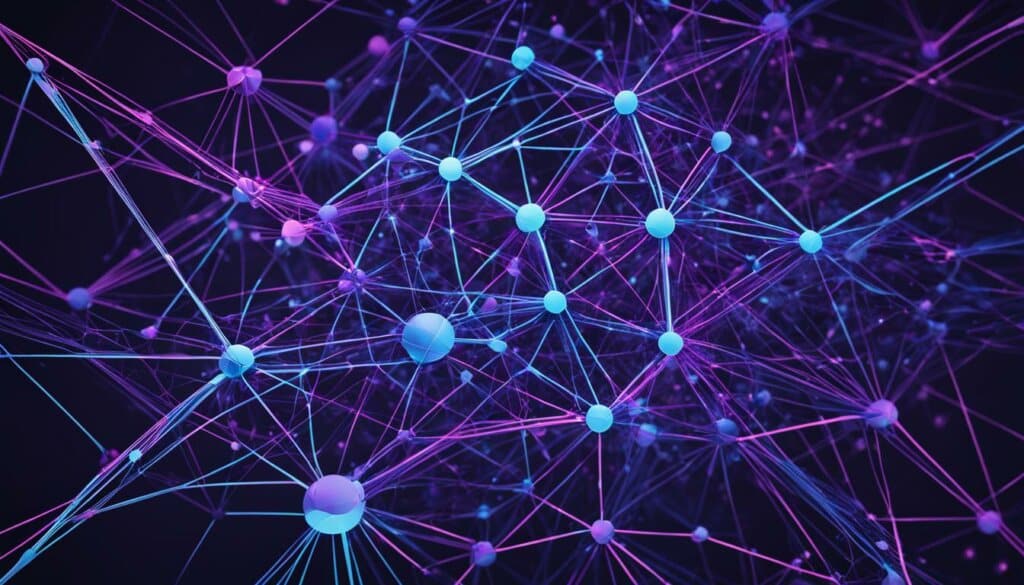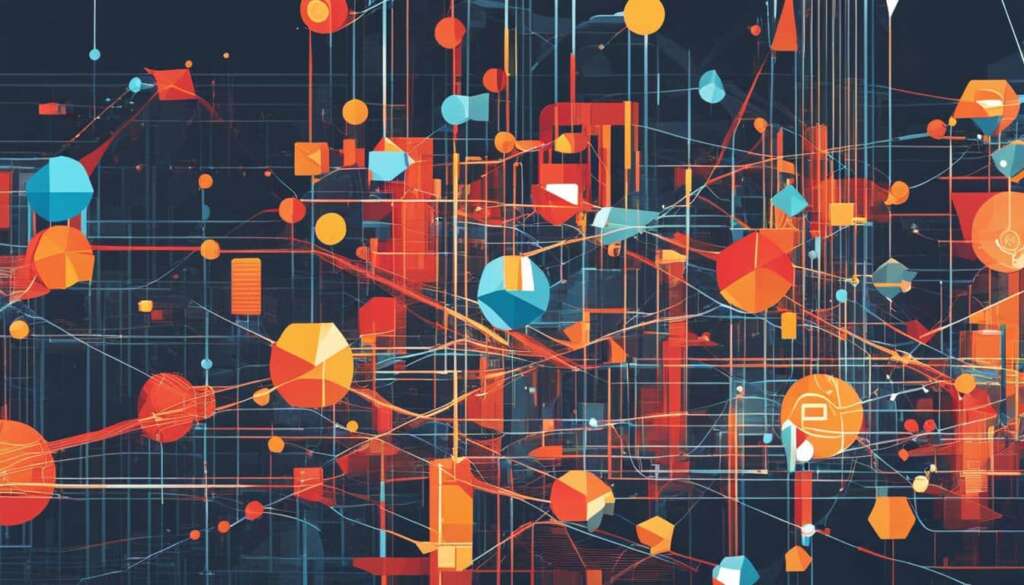Table of Contents
ChatGPT is a powerful artificial intelligence program that revolutionizes the world of chatbots and virtual assistants. Built on advanced machine learning algorithms, ChatGPT harnesses the latest advancements in natural language processing and deep learning to provide intelligent responses and assistance.
Whether you are seeking answers to specific questions, engaging in meaningful conversations, or requiring support with various tasks, ChatGPT’s functions and mechanisms have got you covered. It is designed to understand the nuances of human language and generate human-like responses that are both informative and helpful.
At its core, ChatGPT is powered by a large language model trained by OpenAI. This means that it has extensively learned from vast amounts of text data, making it capable of comprehending a wide range of topics and domains.
The functioning of ChatGPT is made possible by a deep learning architecture known as a transformer. This neural network-based model allows ChatGPT to process and analyze text data with unparalleled accuracy and speed. By predicting the next word based on the context and previous words, ChatGPT generates responses that are contextually relevant and coherent.
One of the key mechanisms employed by ChatGPT is its attention mechanism. This mechanism enables ChatGPT to selectively focus on crucial parts of the input, leading to more precise and contextually appropriate responses. Through the careful utilization of attention, ChatGPT ensures that it accurately understands the intent and meaning behind each query it receives.
ChatGPT’s robustness and adaptability are further enhanced by its continuous learning capability. As it interacts with more users and receives feedback, ChatGPT fine-tunes its responses and updates its knowledge base. This ensures that it stays up to date with the latest information and constantly improves its performance over time.
Stay tuned as we delve deeper into the fascinating world of ChatGPT, exploring its functionalities, applications, and potential for transforming the way we engage with conversational AI.
What is ChatGPT?
ChatGPT is an artificial intelligence program that utilizes machine learning algorithms to generate responses to various queries and tasks. It is specially designed to understand natural language and provide human-like responses, making it an effective tool for answering questions, engaging in conversations, and assisting with specific tasks.
At its core, ChatGPT is trained using a powerful technique called deep learning. This involves the use of a sophisticated neural network architecture known as a transformer, which enables it to analyze and process large volumes of textual data for improved accuracy and context-aware responses.
One of the remarkable qualities of ChatGPT is its ability to constantly learn and update its knowledge base. By receiving more input, it continues to refine its responses and adapt to new information. This makes ChatGPT highly versatile and capable of delivering prompt, intuitive, and up-to-date responses across a wide range of topics and domains.
“ChatGPT’s machine learning capabilities enable it to understand natural language and provide human-like responses. Its deep learning architecture, powered by transformer models, ensures accurate and contextually relevant answers to user queries.”
The application of ChatGPT extends beyond mere text generation. With its advanced artificial intelligence capabilities, it has the potential to revolutionize virtual assistance, customer support, knowledge management, and various other tasks in which human-like interactions are required. Whether it’s building virtual assistants, creating email responders, or assisting with IT service desks and HR tasks, ChatGPT serves as a powerful asset in driving efficiency and improving user experiences.
How does ChatGPT work?
ChatGPT operates by utilizing machine learning algorithms to analyze extensive amounts of text data in order to generate responses that resemble human-like conversation. At its core, it employs a neural network-based architecture known as a transformer, enabling it to predict the next word based on contextual cues and the preceding word. This sophisticated system employs natural language processing techniques to analyze sentence structures and identify key entities, thus enabling a more nuanced understanding of user queries.
The attention mechanism is a crucial component of ChatGPT’s functionality. It enables the model to selectively focus on specific parts of a given input, allowing for greater accuracy in generating responses. By attending to the most important and relevant elements, ChatGPT can generate highly contextually appropriate answers.
ChatGPT and its underlying transformer architecture revolutionize natural language processing, combining advanced machine learning algorithms with a deep understanding of semantic structures, resulting in remarkably lifelike conversations and responses.
Additionally, ChatGPT leverages its language model’s extensive training to continuously learn and adapt. As the model is exposed to more data, it refines its understanding of language nuances, enhancing the quality and aptness of its generated responses over time.

By harnessing the power of advanced neural networks, natural language processing, and attention mechanisms, ChatGPT pushes the boundaries of conversational AI, offering a sophisticated language model with impressive human-like capabilities. Its ability to process and generate text has numerous practical applications, providing valuable assistance across a diverse range of industries and sectors.
Common Use Cases for ChatGPT
ChatGPT is a versatile AI program that finds applications in various industries. Some common use cases for ChatGPT include:
- Building Virtual Assistants: ChatGPT can be used to create virtual assistants that perform tasks such as scheduling appointments and providing customer service. These virtual assistants use natural language processing to understand and respond to user queries, making them valuable tools for enhancing customer interactions.
- Generating Automated Email Responders: ChatGPT can be trained to generate automated responses for common customer inquiries. This helps streamline customer support processes, providing timely and accurate responses to frequently asked questions.
- Creating Knowledge Bases: ChatGPT can be leveraged to create knowledge bases that answer common questions. By training the model on a repository of information, it can provide instant and accurate responses, reducing the need for manual intervention in addressing routine inquiries.
- Providing IT Service Desk Assistance: ChatGPT can be used to automate IT support processes by providing assistance for common IT-related issues. This enables faster problem resolution and frees up resources within the IT service desk.
- Assisting with HR-related Tasks: ChatGPT can support HR teams by providing automated assistance for tasks such as answering frequently asked HR questions, providing onboarding information to new employees, and assisting with leave management.
“ChatGPT’s versatility makes it an invaluable tool for various industries, enhancing customer interactions, streamlining support processes, and providing quick and accurate assistance.”
Additionally, ChatGPT can be employed for document automation, language translation, and generating meeting summaries, further expanding its utility across different domains.
| Use Case | Benefits |
|---|---|
| Building Virtual Assistants | Improved customer interactions, enhanced customer support |
| Generating Automated Email Responders | Streamlined customer support processes, faster response times |
| Creating Knowledge Bases | Instant and accurate responses to common inquiries, reduced manual intervention |
| Providing IT Service Desk Assistance | Faster problem resolution, reduced workload for IT service desk |
| Assisting with HR-related Tasks | Quick and accurate HR information, improved HR processes |
These diverse applications highlight the value of ChatGPT as a powerful AI tool for enabling efficient and intelligent automation in a range of business scenarios.
Conclusion
ChatGPT, an advanced artificial intelligence program, harnesses the power of natural language processing and deep learning techniques to generate responses that closely mimic human communication. With its wide range of applications, ChatGPT is invaluable in industries such as virtual assistance, customer support, and knowledge management.
As ChatGPT constantly receives input and feedback, it continues to evolve and enhance its capabilities. Its deep learning model and advanced language processing enable it to understand and respond to queries in a more accurate and nuanced manner.
Utilizing a powerful language model and the principles of deep learning, ChatGPT demonstrates its potential as a versatile tool for conversational AI and language generation. Its ability to analyze and process large volumes of text data allows it to excel at tasks that require natural language understanding and contextual responses.
In summary, ChatGPT exemplifies how artificial intelligence, natural language processing, language models, and deep learning techniques fuse together to create a remarkable AI program capable of engaging in human-like conversations and providing valuable assistance in various industries.
FAQ
What is ChatGPT?
ChatGPT is an artificial intelligence program that uses machine learning algorithms to generate responses to various queries and tasks. It is designed to understand natural language and provide human-like responses to help answer questions, carry out conversations, and assist with certain tasks. It is trained using a deep learning architecture called a transformer, which allows it to analyze and process large amounts of text data.
How does ChatGPT work?
ChatGPT works by applying machine learning algorithms to a large amount of text data to generate human-like responses. It uses a neural network-based architecture called a transformer, which allows it to predict the next word based on the previous word and context. ChatGPT also uses natural language processing techniques to analyze the structure of sentences and identify entities. It incorporates an attention mechanism to selectively focus on certain parts of the input for more accurate responses.
What are the common use cases for ChatGPT?
ChatGPT is used in various applications, such as building virtual assistants for tasks like scheduling and customer service, generating automated responses for common customer inquiries, creating knowledge bases to answer common questions, providing automated assistance for IT-related issues, and assisting with HR-related tasks. It can also be used for document automation, language translation, and generating meeting summaries.













